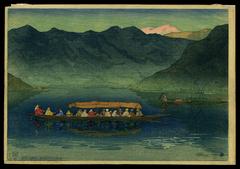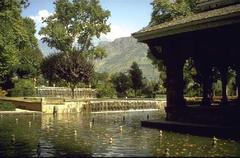Visiting Pari Mahal: History, Tickets, Hours, and Tips
Date: 16/08/2024
Introduction
Pari Mahal, often referred to as the ‘Palace of Fairies,’ stands as a historic testament to the grandeur of Mughal architecture and the rich cultural tapestry of India. Perched on the Zabarwan Mountain Range overlooking the serene Dal Lake in Srinagar, this architectural marvel was constructed in 1650 AD by Mughal Prince Dara Shikoh, the eldest son of Emperor Shah Jahan. Originally, this site was a Buddhist monastery before being transformed into a splendid palace (Kashmir Tickets). The palace is renowned for its seven terraced gardens, each meticulously designed to reflect the Mughal dynasty’s mastery of garden design and construction. The top terrace houses a massive water tank sourced from a natural spring, although many of these water sources have dried up over time.
One of the most remarkable aspects of Pari Mahal is its ingenious water supply system, which employs an intricate network of water tanks and underground pipelines. This engineering marvel is a testament to Mughal ingenuity and their commitment to creating paradise on earth. Beyond its architectural brilliance, Pari Mahal served as a center of learning and artistic expression. Prince Dara Shikoh, a scholar and mystic, delved into the world of astronomy and astrology here, making the palace a hub for intellectual and spiritual pursuits during the Mughal era (Kashmir Tickets).
However, the history of Pari Mahal is also marked by tragedy. It is said that it was here that Prince Dara Shikoh met his untimely demise at the hands of his younger brother, Prince Aurangzeb, during a power struggle within the Mughal dynasty. Today, the preservation of Pari Mahal is of paramount importance, with the Government of Jammu and Kashmir dedicated to maintaining its charm and historical significance for future generations. Visitors are advised to explore the site with care, as many areas are in ruins and require cautious navigation (Kashmir Tickets).
Table of Contents
- Origins and Construction
- Architectural Brilliance
- Waterworks and Engineering
- A Center of Learning
- The Tragic Tale
- Preservation Efforts
- Cultural Significance
- Visitor Tips
- Accessibility
- Nearby Attractions
- Frequently Asked Questions (FAQs)
Origins and Construction
Pari Mahal, also known as the “Palace of Fairies,” is a historical marvel perched on the Zabarwan Mountain Range overlooking the Dal Lake in Srinagar, India. This architectural gem was constructed in 1650 AD by Mughal Prince Dara Shikoh, the eldest son of Emperor Shah Jahan. Originally, the site was a Buddhist monastery before being transformed into the splendid palace we see today (Kashmir Tickets).
Architectural Brilliance
The architecture of Pari Mahal is a testament to the Mughal dynasty’s mastery of garden design and construction. The palace features seven terraces, each meticulously designed to reflect the aesthetic sensibilities of the Mughal era. The terraces are connected by steps, allowing visitors to explore each level gracefully. The top terrace houses a massive water tank sourced from a natural spring, although many of these water sources have dried up over time (Kashmir Tickets).
Waterworks and Engineering
One of the most remarkable features of Pari Mahal is its ingenious water supply system. Unlike other Mughal gardens that boast cascading waterfalls, Pari Mahal employs an intricate network of water tanks and underground pipelines to ensure that each terrace is supplied with water. This engineering marvel is a testament to Mughal ingenuity and their commitment to creating paradise on earth (Kashmir Tickets).
A Center of Learning
Pari Mahal was not just a palace but also a center of learning and artistic expression. Prince Dara Shikoh, a scholar and a mystic, delved into the world of astronomy and astrology here, guided by his mentor, Mulla Shah. The palace served as a hub for intellectual and spiritual pursuits, making it a significant site for scholarly activities during the Mughal era (Kashmir Tickets).
The Tragic Tale
The history of Pari Mahal is also marked by a tragic twist. It is said that this very location was where Prince Dara Shikoh met his untimely demise at the hands of his younger brother, Prince Aurangzeb. The power struggle within the Mughal dynasty played out on these terraces, leaving behind a story as poignant as the architecture itself (Kashmir Tickets).
Preservation Efforts
Pari Mahal has weathered centuries of change and transformation. The preservation of this historical site is of paramount importance, and the Government of Jammu and Kashmir has taken on this responsibility. They are dedicated to maintaining the charm and historical significance of Pari Mahal for generations to come. Visitors are advised to take care while exploring the site, as many areas are in ruins and require cautious navigation (Kashmir Tickets).
Cultural Significance
Pari Mahal stands as a symbol of the Mughal era’s architectural brilliance and intellectual pursuits. The palace’s serene surroundings and breathtaking views of Srinagar and Dal Lake make it a perfect spot to immerse oneself in the past while experiencing the natural beauty of the present. The palace’s name, which means “The Fairies Abode,” adds a layer of mystique and allure, making it a must-visit destination for anyone exploring Srinagar (Kashmir Tickets).
Visitor Tips
For those planning to visit Pari Mahal, it is essential to note that the best time to visit is during the summer months due to the cold and freezing temperatures experienced during winters. The garden opens its gates to the public from 9:30 AM to 5:30 PM, with the last entry permitted until 4:30 PM. Pari Mahal remains closed on Fridays, so plan your visit accordingly. Don’t forget to carry your identification cards for a hassle-free entry (Kashmir Tickets).
Accessibility
Reaching Pari Mahal is a convenient and well-connected journey for tourists. If you’re arriving by train, Srinagar Railway Station is just 19 kilometers away, a short 25-minute ride to the palace. Alternatively, if you’re flying in, Srinagar International Airport is a mere 22 kilometers from Pari Mahal, accessible within 30 minutes by local transportation services (Kashmir Tickets).
Nearby Attractions
After exploring Pari Mahal, visitors can also explore other nearby Mughal masterpieces such as Chashme Shahi Mughal Garden, located just a short 5-minute drive away. Other notable attractions in Srinagar include Shalimar Bagh, Nishat Bagh, Tulip Garden, and the Shankaracharya Temple. These sites offer a blend of natural beauty and historical significance, complementing your exploration of Srinagar’s rich Mughal heritage (Travel Setu).
Frequently Asked Questions (FAQs)
Q: What are the Pari Mahal visiting hours? A: Pari Mahal is open from 9:30 AM to 5:30 PM, with the last entry at 4:30 PM. It is closed on Fridays.
Q: How much are Pari Mahal tickets? A: Ticket prices for Pari Mahal are nominal, typically around ₹20 for Indian citizens and ₹200 for foreign nationals. Prices may vary, so it’s advisable to check the latest rates before your visit.
Q: Are there any guided tours available? A: Yes, guided tours are available, which offer in-depth historical insights and interesting anecdotes about Pari Mahal. It’s recommended to book these tours in advance.
Q: What is the best time to visit Pari Mahal? A: The best time to visit Pari Mahal is during the summer months when the weather is pleasant and conducive for exploring.
Conclusion
Pari Mahal is not just a historical site; it is a living testament to the Mughal era’s architectural brilliance, intellectual pursuits, and tragic tales. Its serene surroundings, breathtaking views, and intricate design make it a must-visit destination for anyone exploring Srinagar. The ongoing preservation efforts ensure that this architectural gem will continue to inspire and captivate visitors for generations to come. For more updates and travel tips, follow us on social media, download our mobile app Audiala, and check out other related posts.


